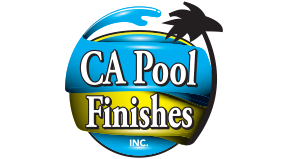CA Pool Finishes Recommended Start Up
The pool finish will start to hydrate and cure immediately after mixing. This time period is when a finish is most susceptible to staining, scaling and discoloration. Proper start-up procedures including timely brushing and constant monitoring and adjusting of the pool water is mandatory. The following recommended start-up will provide best results. Brushing and monitoring chemical will be mandatory by the pool owner or a trained pool technician during the service life of any pool surface. NEVER MIX CHEMICALS–ALWAYS ADD CHEMICALS TO WATER, NEVER WATER TO CHEMICALS.
EXPOSED
Step 1. Make sure the filtration equipment is operational.
Step 2. Fill the pool to the middle of the skimmer or specified water level without interruption as rapidly as possible using clean potable, water without interruption, to help prevent a bowl ring. Place a clean rag on the end of the hose placed at the deepest area of the pool to prevent plaster damage.
Step 3. At no time should any person be allowed in the pool during the filling process.
Step 4. Test the fill water for pH, total alkalinity, calcium hardness, and metals. Record test results.
Step 5. Start the filtration system immediately when the pool is full to the middle of the skimmer or specified water level.
DAY 1
Step 1. Test the pool water for pH, total alkalinity, calcium hardness, and metals. Record test results.
Step 2. High total alkalinity should be lowered to 80 ppm (mg/l) using pre-diluted Muriatic Acid (31-33% Hydrochloric acid). Always pre-dilute the acid by adding it to a 5-gallon (19 L) bucket of pool water2.
Step 3. High pH should be reduced to 7.2 if the alkalinity is already 80-100 ppm (mg/l) using pre-diluted Muriatic Acid (31-33% hydrochloric).
Step 4. Add a pre-diluted quality, testable sequestering agent to achieve 15-20 ppm (mg/l).
Step 5. Brush the entire pool surface thoroughly at least twice daily to homogenize chemicals and remove plaster dust.
Step 6. Operate filtration system continuously a minimum of 72 hours.
Step 7. DO NOT add chlorine for 48 hours. This can unintentionally create fallout and cause metal precipitation which may stain or discolor the surface.
DAY 2
Step 1. Repeat DAY 1 steps 1 thru 4.
Step 2. Operate filtration system continuously a minimum of 48 hours.
Step 3. Brush the pool surface thoroughly at least twice daily to homogenize added chemicals and remove plaster dust.
DAY 3
Step 1. Repeat DAY 1 steps 1 thru 4.
Step 2. Start to increase the total alkalinity slowly over the next 4 days to 80 ppm (mg/l).
Step 3. Pre-diluted chlorine may now be added to achieve 1.5 to 3 ppm (mg/l)¹. NO SALT SHOULD BE ADDED FOR 28 DAYS.
Step 4. Brush the pool surface thoroughly at least twice daily to homogenize added chemicals and remove plaster dust.
DAY 4TH THROUGH 28TH
Step 1. Repeat 1st DAY steps 1 thru 5 every 2 days for 28 days to help prevent scaling and staining of the pool surface.
Step 2. After 4th Day - calcium levels should be adjusted slowly, not to exceed 200 ppm (mg/l)¹, during the next 28 days.
Step 3. After 4th Day - adjust cyanuric acid levels to 30-50ppm (mg/l) based on primary sanitizer of the pool (pre-dissolve through skimmer).
Step 4. On the 7th day any remaining plaster dust may be removed by vacuuming with a brush pool vacuum.
Balanced water chemistry is as critical during the off-season months as it is in season. Water will become just as aggressive because of rain, snow, and fill water as with the regular use of chemicals. Adjust your pH and alkalinity weekly; monitor and adjust calcium hardness and cyanuric acid monthly.
DAILY WATER CHEMISTRY AFTER DAY 28
Maintain the water chemistry using the Langelier Saturation Index (LSI) maintained between 0.0 and +0.3.
Free Chlorine 1 to 3 ppm (mg/l)¹ (ORP 700)
Total Chlorine 0.0 ppm (mg/l)
pH 7.2 – 7.6
Alkalinity 80 – 120 ppm (mg/l)
Testable Sequestering Agent as per manufacturer’s instructions
Calcium hardness 200 – 350 ppm (mg/l)
Cyanuric acid 30 – 50 ppm (mg/l)
TDS 300-1800 ppm (mg/l) (non-salt pools
(Saltwater chlorination only) Salt level 2500 – 3500 ppm (mg/l)
Deterioration, discoloration and scaling as a result of the premature or improper use of chemicals and/or chemical feeders are the responsibility of the equipment installer and pool operator. Feeders other than ORP and pH controllers should not be placed in operational for a minimum of 28 days.
Failure to follow the manufacturer and/or applicator instructions and control the LSI may cause detrimental effects, which is not the result of improper workmanship or a manufacturer’s defect.
CA Pool Finishes Recommended Start Up
The pool finish will start to hydrate and cure immediately after mixing. This time period is when a finish is most susceptible to staining, scaling and discoloration. Proper start-up procedures including timely brushing and constant monitoring and adjusting of the pool water is mandatory. The following recommended start-up will provide best results. Brushing and monitoring chemical will be mandatory by the pool owner or a trained pool technician during the service life of any pool surface. NEVER MIX CHEMICALS–ALWAYS ADD CHEMICALS TO WATER, NEVER WATER TO CHEMICALS.
